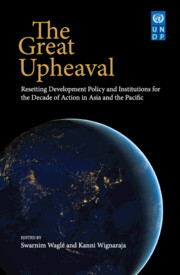Book contents
- Frontmatter
- Contents
- List of Figures
- List of Tables
- List of Boxes
- List of Appendices
- List of Abbreviations
- Foreword
- Acknowledgements
- Introduction
- 1 Aligning Sovereign Debt Financing with Climate Action in the Asia-Pacific Region
- 2 Melting Glaciers, Threatened Livelihoods: Confronting Climate Change to Save the Third Pole
- 3 Accelerating Universal Digital Connectivity
- 4 The Post-COVID-19 Future for Global Value Chains
- 5 Is Southeast Asia Falling into a Latin American–Style Middle-Income Trap?
- 6 Equality of Opportunity as a Measure of Development
- 7 Insights for Policymaking from the Multidimensional Poverty Index
- 8 COVID-19 and Human Security
- 9 Making COVID-19 Vaccine Universally Accessible
- 10 Enhancing the Provision of Global Public Goods: Ready for More Realism?
- 11 Asian-Pacific Regional Cooperation in the Post-COVID-19 Era
- 12 Pandemic Governance and Human Development: Early Lessons from Asia
- 13 Seven Lessons for Development Policy from the COVID-19 Pandemic
- About the Contributors
- Index
4 - The Post-COVID-19 Future for Global Value Chains
Published online by Cambridge University Press: 28 February 2022
- Frontmatter
- Contents
- List of Figures
- List of Tables
- List of Boxes
- List of Appendices
- List of Abbreviations
- Foreword
- Acknowledgements
- Introduction
- 1 Aligning Sovereign Debt Financing with Climate Action in the Asia-Pacific Region
- 2 Melting Glaciers, Threatened Livelihoods: Confronting Climate Change to Save the Third Pole
- 3 Accelerating Universal Digital Connectivity
- 4 The Post-COVID-19 Future for Global Value Chains
- 5 Is Southeast Asia Falling into a Latin American–Style Middle-Income Trap?
- 6 Equality of Opportunity as a Measure of Development
- 7 Insights for Policymaking from the Multidimensional Poverty Index
- 8 COVID-19 and Human Security
- 9 Making COVID-19 Vaccine Universally Accessible
- 10 Enhancing the Provision of Global Public Goods: Ready for More Realism?
- 11 Asian-Pacific Regional Cooperation in the Post-COVID-19 Era
- 12 Pandemic Governance and Human Development: Early Lessons from Asia
- 13 Seven Lessons for Development Policy from the COVID-19 Pandemic
- About the Contributors
- Index
Summary
INTRODUCTION
There are two ‘unbundlings’ that have taken place in the modern economy (Baldwin, 2011). The first is the geographical separation of production and consumption, visible in the growth of world trade post-1945: consumers became increasingly less reliant on national sources of supply, while producers became increasingly less reliant on national markets for their output. More recently, the production process itself has undergone a similar disintegration. For much of the 20th century, goods were largely produced in one place using domestic supply chains (even if shipped somewhere else for final consumption), but the latter part of the 20th century and the first decades of the 21st have seen an important shift towards the internationalization of production. From domestic supply chains, we have increasingly moved towards global value chains (GVCs), which divide production into distinct units, split across locations according to narrow patterns of comparative advantage. Indeed the ‘chain’ terminology is something of a misnomer: GVCs, in fact, operate more like networks, in the sense that they are complex and nonlinear, rather than linear chains.
Conceptually, a value chain “describes the full range of activities that firms and workers do to bring a product/good or service from its conception to its end use and beyond. This includes activities such as design, production, marketing, distribution, and support to the final consumer” (Frederick, 2016). A GVC, therefore, arises when actors carry out these activities in different countries, rather than within the confines of a single country. As the International Trade Center (2017) points out, many GVCs are regional rather than global in scope, as they focus on firms within a single geographical region covering more than one country. True GVCs are most frequently the domain of very large firms that have the resources to research and coordinate suppliers from all over the globe, but the analysis of GVCs and regional value chains (RVCs) is conceptually very similar, so we combine them into a single analysis here, only drawing a distinction when it has analytical salience.
From an analytical standpoint, the rise of GVCs favours a number of shifts in emphasis in thinking about trade and investment relationships (Cattaneo et al., 2013). On the one hand, spreading production activities across numerous countries tends to make countries somewhat less relevant as units of analysis, and firms somewhat more relevant.
- Type
- Chapter
- Information
- The Great UpheavalResetting Development Policy and Institutions in the Asia-Pacific, pp. 100 - 118Publisher: Cambridge University PressPrint publication year: 2022
- 1
- Cited by



